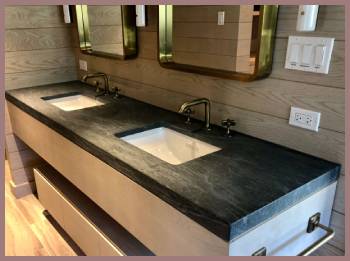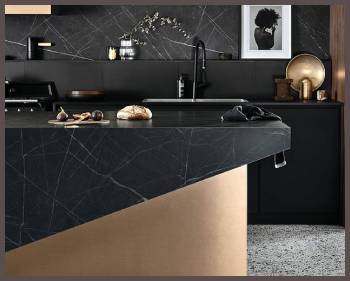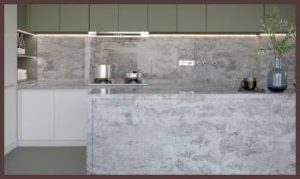Are you caught between a rock and a hard place trying to decide whether to go with Pietra Cardosa or Soapstone for your next construction or remodeling project?
These two materials are popular for their unique characteristics, but choosing between them can be a bit tricky.
A Brief Comparison Table
| Feature | Pietra Cardosa | Soapstone |
| Origin | Italy | Ancient seabeds |
| Color Range | Deep gray with faint white veining | Milky white to gray or black |
| Durability | High; resistant to scratches and wear | Moderate; prone to scratches and dents |
| Heat Resistance | Yes | Yes |
| Porosity | Non-porous | Non-porous |
| Maintenance | Low; no sealing required | Moderate; regular oiling required |
| Cost | High | Varies; usually comparable to high-quality quartz |
| Aesthetic | Contemporary and elegant | Warm and rustic, ages with patina |
| Use Cases | Kitchen countertops, fireplace surrounds, etc. | Kitchen countertops, fireplaces, etc. |
Remember, both Pietra Cardosa and Soapstone offer unique benefits, and both can enhance your space in their unique ways. Weigh the pros and cons, consider your specific needs and desires, and choose the stone that will make you love your space.
After all, you’ll be the one living with it every day.
A Closer Look at Pietra Cardosa

Pietra Cardosa is an elegant, understated natural stone quarried from the rich geological heartlands of Italy. Its color palette is a cool, deep gray, often with faint white veining that adds subtle character. It’s remarkably smooth, and its matte finish can lend any space a refined and contemporary vibe.
Pros of Pietra Cardosa
A primary advantage of Pietra Cardosa is its durability. It’s resilient, resistant to scratches, and can withstand daily wear and tear effortlessly. This durability translates to low maintenance costs, making it a cost-effective option for long-term applications.
Moreover, Pietra Cardosa doesn’t need any sealing because it’s naturally non-porous, an ideal feature for areas susceptible to spills. It’s also heat-resistant, making it perfect for kitchen countertops or fireplace surrounds.
Cons of Pietra Cardosa
Despite its many virtues, Pietra Cardosa does have some drawbacks. It is a more expensive material than some other natural stones. While its durability can offset the high initial cost over time, it can still be a deterrent for budget-conscious customers.
Moreover, it’s predominantly available in shades of gray, which might limit your color options. Lastly, due to its weight, it requires professional installation.
Read More: About Schaub Hardware
Unveiling the Mystery of Soapstone

On the other hand, Soapstone is a metamorphic rock that originated in ancient seabeds. It’s dense, non-porous, and ranges in color from a milky white to gray or black. Each slab of soapstone is distinctive, typically characterized by subtle veining, which contributes to its unique charm.
Pros of Soapstone
Soapstone is heat-resistant, making it perfect for kitchen countertops where hot pots and pans are a common occurrence. It’s also non-porous, so it doesn’t require sealing and is resistant to staining.
Another advantage is its tactile appeal. Soapstone feels soft and warm to the touch. Over time, it develops a beautiful patina that adds to its character, making it perfect for those who appreciate a material that ages gracefully.
Cons of Soapstone
The biggest disadvantage of soapstone is its softness, which makes it prone to scratches and dents. However, these imperfections can be easily sanded out or integrated into the aged aesthetic that some homeowners love.
Soapstone also requires regular oiling to keep it looking its best. Although it’s a simple process, it does add an extra step to the maintenance routine.
Read More: About Pompeii Quartz
Pietra Cardosa and Soapstone: Side by Side
In the faceoff between Pietra Cardosa and Soapstone, both stand their ground with distinct advantages. Pietra Cardosa champions the fight with its robustness, modern aesthetics, and low maintenance, while soapstone brings its unique tactile appeal, patina development, and heat resistance to the table.
The choice between Pietra Cardosa and soapstone depends on personal preferences and project specifics. However, it’s important to remember that neither is inherently superior; they’re just different.
Frequently Asked Questions (FAQs)
No, Pietra Cardosa is not a soapstone. While they both share similar traits like being heat resistant and non-porous, they are different types of natural stones.
Pietra Cardosa is very durable. It’s resistant to scratches and can handle daily wear and tear quite well.
In general, the cost of natural stones can vary widely depending on many factors. Quartz, being a man-made material, tends to have a more consistent price range. Typically, high-quality soapstone and quartz are priced relatively similarly, with variations based on color, quality, and installation costs. However, soapstone’s prices can sometimes be slightly lower than that of quartz.
Soapstone has a unique look and feel that is not easily replicated by other stones. However, in terms of its visual appearance and some of its properties, slate can be considered somewhat similar. Like soapstone, slate is also non-porous and resistant to staining, though it doesn’t develop a patina over time.
The strength of soapstone can vary depending on its talc content. Soapstone with lower talc content is harder and more durable, making it ideal for high-traffic areas like kitchen countertops. Architectural-grade soapstone, which is used for countertops, typically has a lower talc content and is thus quite strong.
No, soapstone is not low grade. Its durability, unique aesthetics, and inherent properties like being non-porous and heat-resistant make it a sought-after material for various applications, from kitchen countertops to fireplaces. Its value is in no way less than other types of stone.
Conclusion: Pietra Cardosa or Soapstone?
Choosing between Pietra Cardosa and soapstone ultimately comes down to your specific needs and aesthetic preferences. Pietra Cardosa exudes an understated elegance with its cool gray tones and modern appeal, while soapstone has a warm, inviting feel with its unique ability to develop a patina over time.
Do you love the tactile appeal of soapstone, or do you prefer the sleekness of Pietra Cardosa? Are you okay with a bit of maintenance, or do you prefer a set-and-forget material? Answer these questions, and you’re one step closer to making the perfect choice for your project.
Remember, both Pietra Cardosa and soapstone offer unique benefits, and both can enhance your space in their unique ways. Weigh the pros and cons, consider your specific needs and desires, and choose the stone that will make you love your space. After all, you’ll be the one living with it every day.
From an analytical perspective, the long-term benefits and value of either stone make them excellent choices for those looking for the perfect balance of aesthetics, durability, and ease of maintenance. So, whether you’re Team Pietra Cardosa or Team Soapstone, you can be sure you’re making a great decision.



